|
 Secure Site
Secure Site
|
 |
Archive for the 'Meditation Timers' Category
 Hokusai Ukiyo-e Print, Umegawa in Sagami Province Mount Fuji (Fuji-san) is the highest mountain in Japan at 12,388 ft. Along with Mount Tate and Mount Haku, it is one of Japan’s “Three Holy Mountains”. An active volcano that last erupted in 1707–08, Mount Fuji is just west of Tokyo, and can be seen on a clear day. Mount Fuji’s exceptionally symmetrical cone is a well-known symbol of Japan and it is frequently depicted in art and photographs, as well as visited by sightseers and climbers.
While Hokusai’s Thirty-six Views of Mount Fuji is the most famous ukiyo-e series to focus on Mount Fuji, there are several other series with the same subject, including Hiroshige’s Thirty-six Views of Mount Fuji and Hokusai’s own later series One Hundred Views of Mount Fuji.
adapted from wikipedia.org
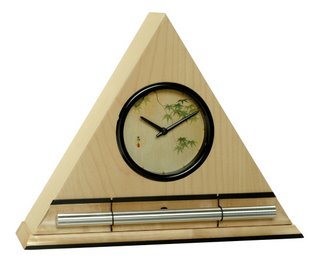 Zen Clocks by Now & Zen
Now & Zen
1638 Pearl Street
Boulder, CO 80302
(800) 779-6383
Posted in Chime Alarm Clocks, Meditation Timers, Meditation Tools, Now & Zen Alarm Clocks, Zen Timers
 Buddhist Loving Kindness Buddhist loving kindness Mettā or maitrī (sanskrit) has been translated as loving-kindness, friendliness, benevolence, amity, friendship, good will, kindness, love, sympathy, and active interest in others.
It is one of the ten paramitas of the Theravada school of Buddhism, and the first of the four Brahmaviharas. The mettā bhāvanā (“cultivation of mettā”) is a popular form of meditation in Buddhism.
“Loving-kindness” is a term first used in the 1535 Coverdale Bible. The idea is associated with the Christian concept of agape, or love of God, which is reflected in the quote:
“God is inherently kind, naturally compassionate, and everlastingly merciful. And never is it necessary that any influence be brought to bear upon the Father to call forth his loving-kindness.”
Beyond Christianity, English translations of the writings of the Bahá’í Faith also use the term “loving-kindness” when referring to the original Persian “mohabbat”.
Buddhist Loving Kindness adapted from wikipedia.org
Posted in Chime Alarm Clocks, Meditation Timers, Meditation Tools, mindfulness practice, Natural Awakening, Now & Zen Alarm Clocks, prayer, Progressive Awakening, Well-being, Yoga Timer, Yoga Timers by Now & Zen, Zen Timers
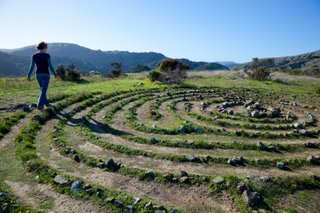 labyrinth, walking meditation Meditation can be practiced while walking or doing simple repetitive tasks. Walking meditation helps break down habitual automatic mental categories, thus regaining the primary nature of perceptions and events, focusing attention on the process while disregarding its purpose or final outcome.
adapted from wikipedia.org
 Zen Clocks by Now & Zen, Boulder, CO
Now & Zen
1638 Pearl St.
Boulder, CO 80302
Posted in Japanese Inspired Zen Clocks, Meditation Timers, Meditation Tools, mindfulness practice
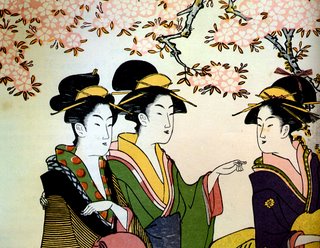 Courtesan Hanaogi of Ogi-ya by Chokosai Eisho, Now & Zen ukiyo-e detail Japanese poets first encountered Chinese Poetry when it was at its peak in the Tang Dynasty. It took them several hundred years to digest the foreign impact, make it a part of their culture and merge it with their literary tradition in their mother tongue, and begin to develop the diversity of their native poetry. For example, in the Tale of Genji both kinds of poetry are frequently mentioned.
A new trend came in the middle of the 19th century. Since then the major forms of Japanese poetry have been tanka (new name for waka), haiku and shi.
In Japan during the ancient times, it was a custom between two writers to exchange waka instead of letters in prose. In particular, it was common between lovers. Soon after in Japan, making and reciting waka became a part of aristocratic culture.
wikipedia.org
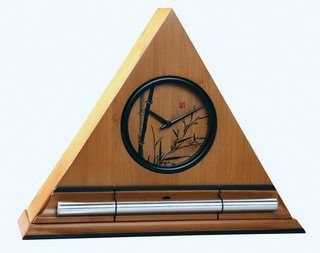 Bamboo Zen Clocks, progressive chime clock and timer Now & Zen Headquarters
1638 Pearl Street
Boulder, CO 80302
(800) 779-6383
Posted in Cherry Blossoms, Japanese Inspired Zen Clocks, Japanese Poetry, Meditation Timers, Meditation Tools, Natural Awakening, Now & Zen Alarm Clocks, Progressive Awakening, Zen Timers
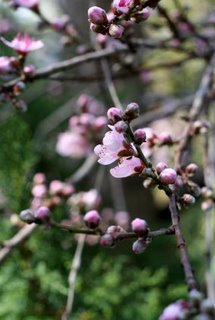 Pink Sakura, Now & Zen Inc. A cherry blossom is the name for the flower of cherry trees known as Sakura in Japanese.
Cherry blossom is an omen of good fortune and is also an emblem of love, affection and represents spring. Cherry blossoms are an enduring metaphor for the fleeting nature of life, and as such are frequently depicted in art.
Cherry blossoms and leaves are edible and both are used as food ingredients in Japan.
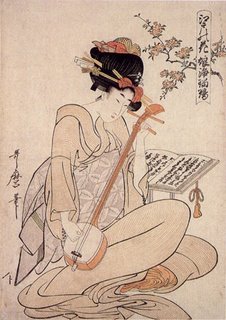 Kitagawa Utamaro Cherry Blossom Flowers of Edo, Now & Zen wikipedia.org
Now & Zen
1638 Pearl St.
Boulder, CO 80302
Posted in Japanese Inspired Zen Clocks, Meditation Timers, Meditation Tools, Natural Awakening, Now & Zen Alarm Clocks, Progressive Awakening, Zen Timers
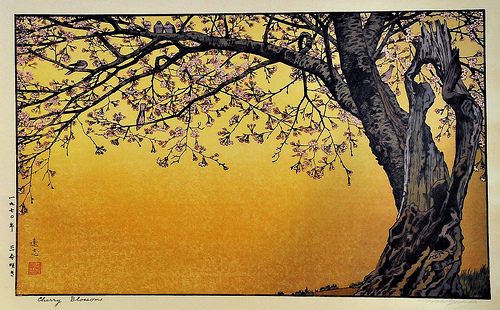 Ukiyo-e Toshi Yoshida Sanbu Zaki Cherry Blossoms In Japan cherry blossoms symbolize clouds due to their nature of blooming en masse, besides being an enduring metaphor for the ephemeral nature of life, an aspect of Japanese cultural tradition that is often associated with Buddhistic influence.
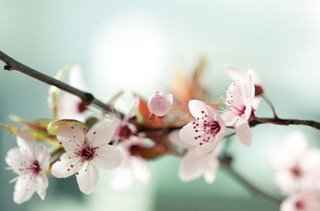 cherry blossoms like clouds The transience of the blossoms, the extreme beauty and quick death, has often been associated with mortality; for this reason, cherry blossoms are richly symbolic, and have been utilized often in Japanese art and film, as well as at musical performances for ambient effect.
from wikipedia.org
 Zen Clocks by Now & Zen, Boulder, CO
Now & Zen Headquarters
1638 Pearl Street
Boulder, CO 80302
(800) 779-6383
Posted in Chime Alarm Clocks, Japanese Inspired Zen Clocks, Meditation Timers, Now & Zen Alarm Clocks, Progressive Awakening
...the art of the ‘tea ceremony’ inspired by Japan continued…
 Zen Timepiece, a timer for the 'way of tea' ceremony In that the Japanese tea ceremony is conventionally conducted sitting on tatami, seiza is integral to it. Unless it is the ryūrei style of tea ceremony, which employs chairs and tables, both the host and guests sit in seiza throughout.
To sit seiza-style, one first kneels on the floor, folding one’s legs underneath one’s thighs, while resting the buttocks on the heels. The ankles are turned outward as the tops of the feet are lowered so that, in a slight “V” shape, the tops of the feet are flat on the floor and big toes are overlapped, and the buttocks are finally lowered all the way down. Depending on the circumstances, the hands are folded modestly in the lap, or are placed palm down on the upper thighs with the fingers close together, or are placed on the floor next to the hips, with the knuckles rounded and touching the floor. The back is kept straight, though not unnaturally stiff. Traditionally, women sit with the knees together while men separate them slightly.
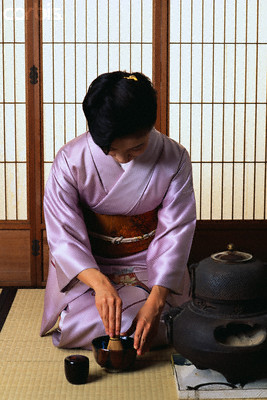 Japanese woman performing tea ceremony in seiza sitting position Stepping into and out of seiza is mindfully performed. There are codified traditional methods of entering and exiting the sitting position depending on occasion and type of clothing worn.
All the bows (there are three basic variations, differing mainly in depth of bow and position of the hands) performed during tea ceremony originate in the seiza position.
from wikipedia.org
Posted in Japanese Inspired Zen Clocks, Meditation Timers, Meditation Tools, Now & Zen Alarm Clocks, Progressive Awakening
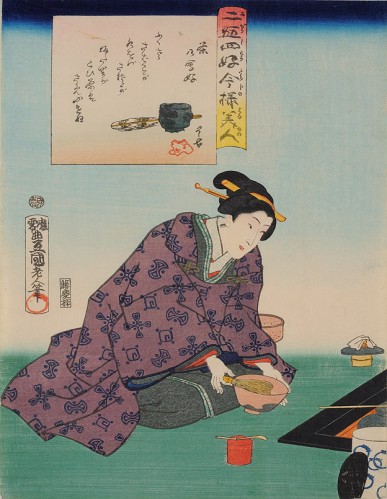 Utagawa Kunisada (1786-1865), a woman performing the tea ceremony The Japanese tea ceremony, also called the Way of Tea, is a Japanese cultural activity involving the ceremonial preparation and presentation of matcha, powdered green tea.
Many of the movements and components of tea ceremony from Japan, evolved from the wearing of kimono and, although it is not uncommon for students nowadays to wear western clothes for practice, most will practice in kimono at least some of the time, for this is essential to learn the prescribed motions properly.
wikipedia.org
 Zen Timer for tea ceremony, black laquer "E" tone digital version Now & Zen
1638 Pearl Street
Boulder, CO 80302
(800) 779-6383
Posted in Chime Alarm Clocks, Japanese Inspired Zen Clocks, Meditation Timers, Now & Zen Alarm Clocks, Tea Ceremony
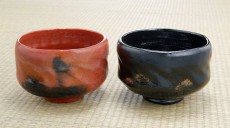 Wabi-Sabi red and black glazed Raku tea cup set ….more musings on wabi-sabi
In one sense wabi sabi is a training where the student of wabi sabi learns to find the most simple objects interesting, fascinating and beautiful. Fading autumn leaves would be an example.
Wabi sabi can change our perception of our world to the extent that a chip or crack in a vase makes it more interesting and give the object greater meditative value. Similarly materials that age such as bare wood, paper and fabric become more interesting as they exhibit changes that can be observed over time.
The wabi and sabi concepts are religious in origin, but actual usage of the words in Japanese is often quite casual.
from Wikipedia
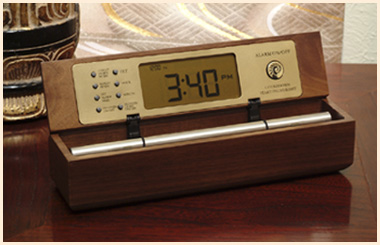 Digital Zen Alarm Clock
Now & Zen
1638 Pearl Street
Boulder, CO 80302
(800) 779-6383
Posted in Japanese Inspired Zen Clocks, Meditation Timers, Meditation Tools, Natural Awakening, Now & Zen Alarm Clocks, Yoga Timers by Now & Zen
« Previous Page
Next Entries »
|
|
|
|